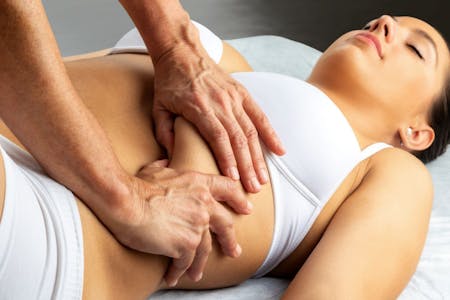
The term "visceral" in this sense pertains to the soft internal organs (visceral organs) of the body. When your skeletal system moves, so do your organs (viscera). Most physical therapists focus on musculoskeletal and nerve movement patterns and not on what lies between them - the viscera. This is what prompted world-renowned French Osteopath and Physical Therapist Jean-Pierre Barral to further study the viscera and fascia and how restrictions in them may cause pain and reduced range of motion in the body. This study ultimately led to his development of visceral manipulation (VM), also known in layman terms as "organ massage".
Visceral manipulation is a hands-on therapy involving gentle pressure on specific areas of the rib cage, abdomen or pelvis to remove restrictions in the layer of tissue and fluid that surround and connect your organs. It focuses on the manipulation of the visceral organs including the stomach, intestines, liver, kidneys, bladder and uterus to allow the body to re-establish its natural ability to adapt and heal.
Visceral manipulation and physical therapy are often used together as a whole body approach to healing the body from injury by addressing fascia restrictions around the nerves, blood vessels, and organs. VM restores normal movement and motility of internal organs. This, in turn can also resolve a multitude of musculoskeletal abnormalities by alleviating compensatory movement patterns by releasing organ and fascia restrictions.
Am I a Good Candidate for Visceral Manipulation?
Visceral manipulation, coupled with manual physical therapy can greatly reduce pain and inflammation, as well help repair tissue and improve overall function throughout the body. It is beneficial for a variety of conditions, including:
- Headaches and Migraines
- Whiplash and Seatbelt Injuries
- Traumatic Brain Injury (TBI)
- Concussions
- Gastrointestional Issues / Digestive Disorders
- Swallowing Abnormalities
- Women's and Men's Health Issues
- Somatic-Visceral Interactions
- Neck Pain
- Chronic Back Pain / Sciatica
- Carpal Tunnel Syndrome
- Peripheral Joint Pain
- Post-operative / Post-infection Scar Tissue
- Autonomic Mechanisms - Sympathetic Nervous System (SNS) and Parasympathetic Nervous System (PSNS)
These are only a few of many conditions that benefit from visceral manipulation.
What to Expect During Your First Visit
When coming in for a visceral manipulation treatment, you will need to be dressed in loose, comfortable clothing so that specific areas of your body can be exposed for assessment and treatment. Or, the physical therapist or osteopath may provide a gown or work on you through a thin layer of clothing. The physical therapist or osteopath will first perform a full assessment to identify abnormal motion and the source of the compensatory pattern in order determine where treatment is needed. He or she will then design a custom treatment plan to address your specific condition.
What Are The Treatments Like?
Visceral manipulation treatments are different depending on where in the body the issue resides. It may involve a light touch or a firm touch with compression, mobilization and/or elongation of the affected areas. For example, if treatment is being performed on scar tissue, the ribcage or digestive tract, there may be some tenderness or mild discomfort because these require a deeper touch. Treatments on the abdomen may cause tenderness, tightness or even gurgling in your stomach. The touch is much lighter for treatments along nerves, arteries or lymph vessels. So, that may feel more like a mild tingling, numbness or heat as blood flow in those areas increases.
After the treatment, you should experience some pain relief. You will probably also be prescribed an in-home exercise program that will typically include include stretching exercises, breathing exercises and/or postural re-education to compliment your in-office treatments. You may also be asked to keep a journal of symptoms you are experiencing, dietary intake and/or toileting habits. Be sure to drink plenty of water and continue treatments, as prescribed, until your pain subsides and function restores.
Contact us to find out more information and see if visceral manipulation is right for you.
